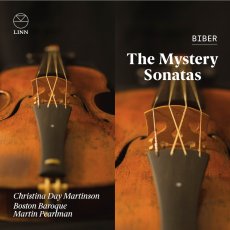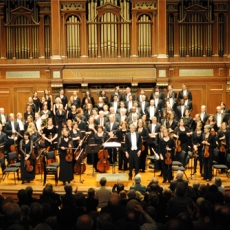Boston Baroque - Biber: The Mystery Sonatas - Infodad
One of the absolute marvels of Baroque music by one of the most innovative composers of the time, Heinrich Ignaz Franz von Biber’s Mystery Sonatas are musically enthralling, emotionally captivating and spiritually uplifting in a way more usually associated with Bach – who was not born until a decade after Biber wrote this music. Biber was a highly accomplished violinist, to such an extent that he stretched the bounds of violin performance capability in directions previously unheard-of. The word “stretched” can be taken literally: the Mystery Sonatas use scordatura tuning, tuning different from the standard one for the violin, and in some cases this requires stretching the strings (which were, of course, made of gut – which is quite stretchable). It also requires violinists to stretch their technique, since their fingerings in scordatura tuning do not produce the same notes as in traditional tuning. Just how differently Biber made the violin sound for these 15 sonatas is made clear by Christina Day Martinson in her splendid new performance on Linn Records: she opens each sonata by playing the specific four notes to which the violin is tuned for that particular work. The complexity of the tunings and the difficulties associated with them lead Martinson, a superb period-instrument player, to use multiple violins for this performance – a clever and instrument-and-string-sparing approach. There are scarcely enough superlatives to say how well Martinson’s handling of this magnificent music works. There are 15 sonatas because there are 15 Mysteries of the Rosary, and Biber clearly intended the sonatas to accompany Rosary devotions – probably as, in most cases, a generic aid to contemplation, since the sonatas have few direct connections to the scenes of Christ’s and Mary’s lives to which they are attached (each sonata is, in the sole surviving manuscript, preceded by an illustration of the relevant scene, all of which are reproduced in the booklet accompanying this performance). It is not necessary to be Catholic, or even particularly religious, to be uplifted by hearing this marvelous sonata cycle, more than two hours long, from start to finish. And it is almost impossible not to be enthralled by the different sounds that Biber uses scordatura tuning to have the violin produce and that Martinson brings out so beautifully: the brighter sounds of the first five sonatas (collectively, “The Joyful Mysteries”) contrast so strongly with the opening of the sixth, “The Agony in the Garden” (which starts the second set of five, “The Sorrowful Mysteries”) that it is almost impossible not to sit up and take astonished notice. And the final set of five sonatas, “The Glorious Mysteries,” is so bright and clear that it tells the story of Jesus’ resurrection and Mary’s assumption and coronation more effectively than any words can on their own. Martinson is at the forefront of a highly welcome trend in Baroque performance practice, which involves not only the scholarly rediscovery of correct instrumental use and technique but also – and equally important – the re-learning of the very intense emotions sought and elicited by Baroque composers in their compositions. Decades of dry performances of music of this era will not prepare listeners for the extraordinary intensity of feeling in the Mystery Sonatas and Martinson’s highly sensitive evocation of it. After the 15 sonatas, an extended concluding Passacaglia, which uses traditional violin tuning – also employed only in the very first sonata, “The Annunciation” – becomes a capstone that gives listeners a chance to breathe a monumental sigh of relief and to contemplate the amazing beauty and variety to which Biber and Martinson have exposed them. The members of Boston Baroque who accompany Martinson are one and all first-rate, thoughtful musicians whose involvement in Biber’s material is not only audible but also almost palpable. Indeed, this is music that one does not only hear: one feels it, and the feeling with which Martinson plays it underlines the devotional fervor that Biber surely intended to explore in his own time and that is here transferred beautifully and meaningfully to our own, far more secular age.

